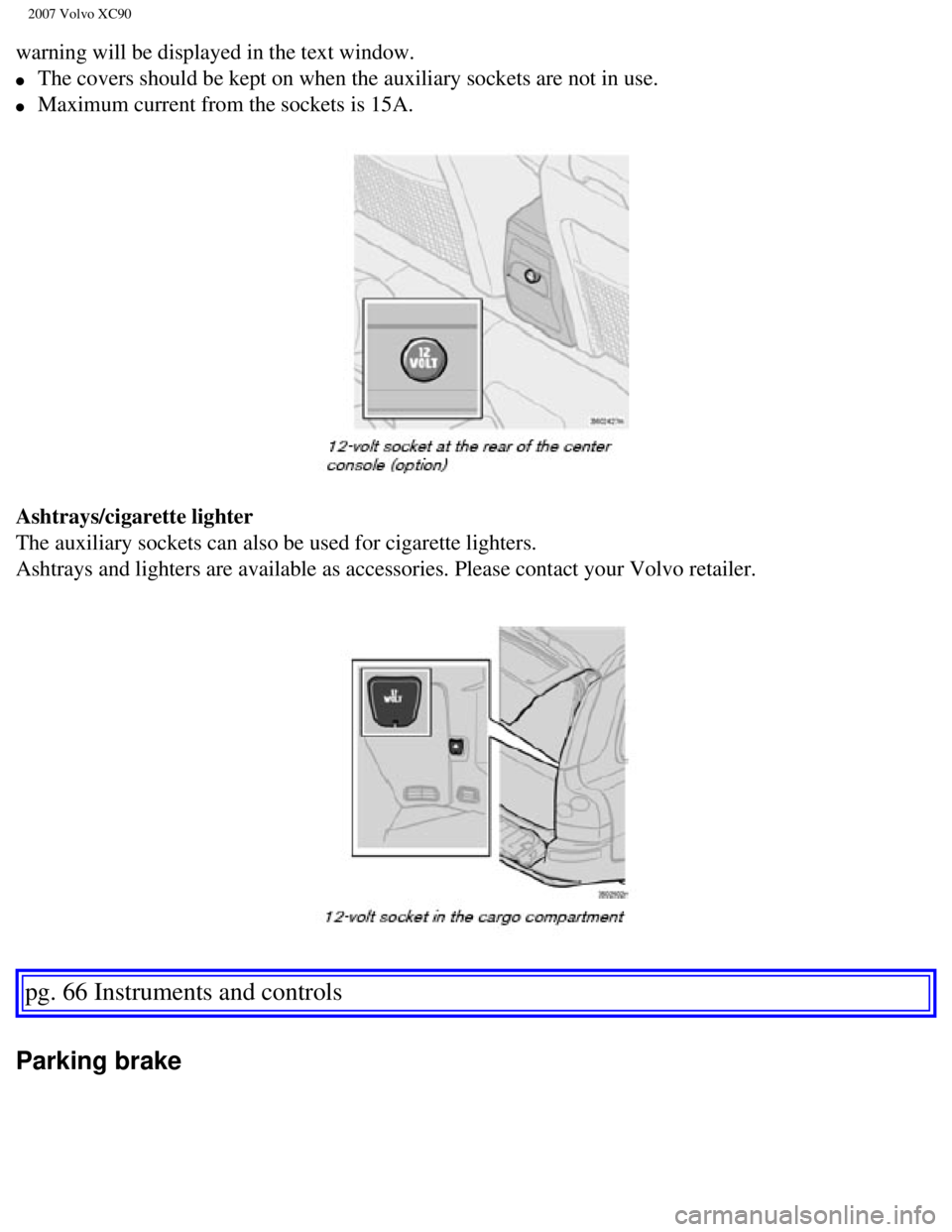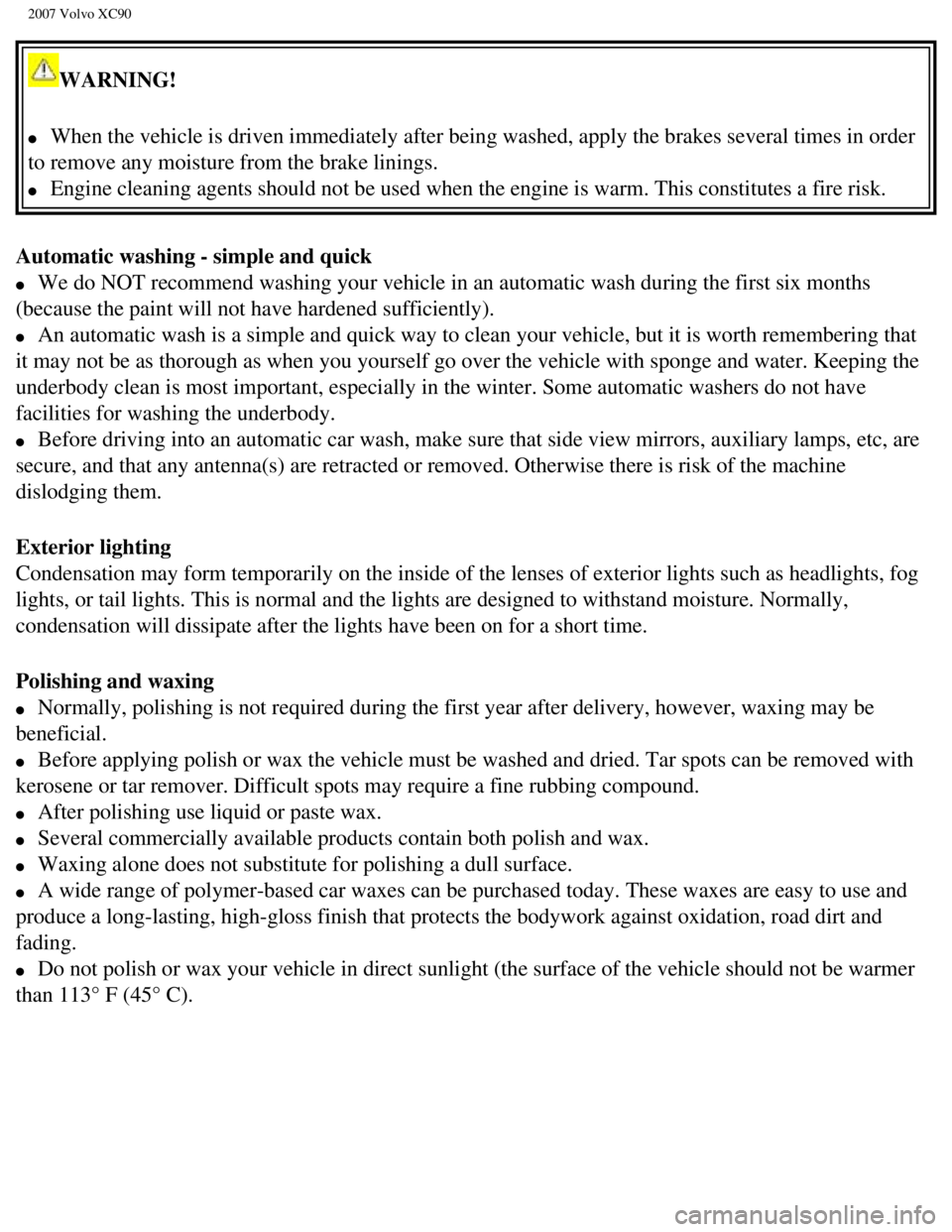2007 VOLVO XC90 AUX
[x] Cancel search: AUXPage 47 of 268

2007 Volvo XC90
2 0 0 7
VOLVO XC90
Instruments and controls
pg. 43 Instruments and controls
Instrument overview
44
Instrument panel
46
Indicator and warning symbols
47
Switches in the center console
52
Steering wheel adjustment
54
Lighting panel
55
Left-side steering wheel lever
58
Right-side steering wheel lever
59
Hazard warning flashers, rear window/sideview mirror
defroster
61
Trip computer
62
Cruise control
63
Auxiliary 12-volt sockets
65
Parking brake
66
Opening the hood and tailgate
67
Power windows
68
Rearview mirror/power folding sideview mirrors
70
Power moonroof (option)
73
pg. 44 Instruments and controls
Instrument overview
file:///K|/ownersdocs/2007/2007_XC90/07xc90_02.htm (1 of 40)12/30/2006\
5:53:37 PM
Page 58 of 268

2007 Volvo XC90
NOTE: The system activates automatically when the engine is started, and can \
be deactivated by
pressing this button (e.g. when towing a trailer) or reactivated if ne\
cessary.
pg. 53 Instruments and controls
Switches in the center console
Temporarily disconnecting the alarm sensors (option)
See
page 112 for more details.
Auxiliary lights
This button is used to switch on auxiliary lights (if installed). A li\
ght in the button will light up to
indicate that the auxiliary lights are illuminated.
12 volt socket
This 12 volt socket can be used to plug in certain accessories such as c\
ellular telephones, etc. The
ignition key must be in position I (or higher) for the auxiliary socke\
t to function.
NOTE: The auxiliary sockets can also be used for cigarette lighters, which ar\
e available as accessories
at your Volvo retailer.
Power child locks (option)
See
page 110 for more information on this function.
file:///K|/ownersdocs/2007/2007_XC90/07xc90_02.htm (12 of 40)12/30/200\
6 5:53:37 PM
Page 72 of 268

2007 Volvo XC90
l the gear selector is placed in (N)eutral
l the wheels start to spin or lock
l if an increase in speed is maintained for more than one minute
l if the vehicle's speed falls below approximately 20 mph (30 km/h).
pg. 64 Instruments and controls
Cruise control
Temporarily disengaging cruise control
l Press 0 to temporarily disengage cruise control. CRUISE will be displaye\
d in the information window
in the instrument panel.
l Press the brake pedal.
Press "resume"
to return to the previously set speed.
WARNING!
Cruise control should not be used in heavy traffic or when driving on we\
t or slippery roads, or when
driving on unpaved or uneven road surfaces. Cruise control may not maint\
ain set speed on steep
downgrades.
pg. 65 Instruments and controls
Auxiliary 12-volt sockets
12 volt sockets
These 12 volt sockets can be used to plug in certain accessories such as\
cellular telephones, etc.
The ignition key must be in at least position I for the sockets in the f\
ront seat and the optional socket at
the rear of the center console to function.
12-volt socket in the cargo compartment
Fold down the lid to use the socket. This socket can be used even if the\
ignition is switched off.
NOTE:
l If the 12-volt sockets are used while the engine is not running, there i\
s a risk that the vehicle's battery
will be discharged.
l If the ignition is switched off and a device drawing more than 0.1A is c\
onnected to a socket, a battery
file:///K|/ownersdocs/2007/2007_XC90/07xc90_02.htm (26 of 40)12/30/200\
6 5:53:37 PM
Page 73 of 268

2007 Volvo XC90
warning will be displayed in the text window.
l The covers should be kept on when the auxiliary sockets are not in use. \
l Maximum current from the sockets is 15A.
Ashtrays/cigarette lighter
The auxiliary sockets can also be used for cigarette lighters.
Ashtrays and lighters are available as accessories. Please contact your \
Volvo retailer.
pg. 66 Instruments and controls
Parking brake
file:///K|/ownersdocs/2007/2007_XC90/07xc90_02.htm (27 of 40)12/30/200\
6 5:53:37 PM
Page 143 of 268

2007 Volvo XC90
l At a distance of approximately 1 foot (30 cm), the signal will become \
constant. If objects are close to both the front and
rear bumpers, the signal will alternate between the front and rear speak\
ers.
Deactivating the system(s)
- Press the Park assist button on the center console (see
page 52) to temporarily deactivate the system(s).
- The indicator light in the button will go out when the system(s) hav\
e been deactivated.
- If the vehicle is equipped with front and rear park assist, both syste\
ms will be deactivated by pressing the button.
Park assist will be automatically reactivated the next time the engine i\
s started.
NOTE: It may be necessary to deactivate one or both of the park assist system\
s in certain cases.
l Rear park assist: towing a trailer, carrying bicycles in a rear-mounted carrier, etc, co\
uld trigger the rear park assist
system's sensors.
l Front park assist: it may not be possible to combine auxiliary headlights and front park \
assist since these lights could
trigger the system's sensors.
pg. 133 Starting and driving
Front/rear park assist (accessory/option)
Faults in the system
If the yellow warning symbol illuminates and a message is shown in the i\
nformation display, the system is not
functioning properly. Consult a Volvo retailer or authorized service tec\
hnician.
Cleaning the sensors
For the system to function properly, the sensors in the front and/or rea\
r bumpers should be kept clean. They can be cleaned
with car washing detergent and a sponge.
WARNING!
These systems are designed to be a supplementary aid when parking the ve\
hicle. They are not, however, intended to
replace the driver's attention and judgement.
CAUTION!
In certain circumstances, the park assist system may give unexpected war\
ning signals that can be caused by external
sound sources that use the same ultrasound frequencies as the system. Th\
is may include such things as the horns of
other vehicles, wet tires on asphalt, pneumatic brakes, motorcycle exhau\
st pipes, etc. This does not indicate a fault in
the system.
pg. 134 Starting and driving
Towing
file:///K|/ownersdocs/2007/2007_XC90/07xc90_06.htm (19 of 32)12/30/200\
6 5:53:44 PM
Page 146 of 268

2007 Volvo XC90
Jump starting
Follow these instructions to jump start your vehicle's dead battery or t\
o jump start another vehicle's dead battery using your
vehicle. Although your vehicle's battery is located under the floor of t\
he cargo area, jumper cables should be connected in
the engine compartment, to the points shown in the illustrations.
If the 12-volt auxiliary battery to be used is in another vehicle, check\
that the vehicles are not touching to prevent
premature completion of a circuit. Be sure to follow jump starting instr\
uctions provided for the other vehicle.
To jump start your vehicle:
- Switch off the ignition.
- First connect the auxiliary battery positive (+) terminal (1) to t\
he positive (+) terminal in your vehicle's engine
compartment (2), located under a small black plastic cover attached to\
the fuse box cover, marked with a "+" sign. Remove
the cover on the main fuse box if necessary to access this terminal. The\
n connect the auxiliary battery's negative (-)
terminal (3) to the ground point in your vehicle's engine compartment \
(4).
- Start the engine in the assisting vehicle, then start the engine in th\
e vehicle with dead battery.
- After the engine has started, first remove the negative (-) terminal\
jumper cable. Then remove the positive (+) terminal
jumper cable.
WARNING!
PROPOSITION 65 WARNING!
Battery posts, terminals, and related accessories contain lead and lead \
compounds, chemicals known to the state of
California to cause cancer and reproductive harm. Wash hands after handl\
ing.
WARNING!
l Do not connect the jumper cable to any part of the fuel system or to any\
moving parts. Avoid touching hot manifolds.
l Never expose the battery to open flame or electric spark.
l Do not smoke near the battery.
l Batteries generate hydrogen gas, which is flammable and explosive.
l Battery fluid contains sulfuric acid. Do not allow battery fluid to cont\
act eyes, skin, fabrics or painted surfaces. If
contact occurs, flush the affected area immediately with water. Obtain m\
edical help immediately if eyes are affected.
l Failure to follow the instructions for jump starting can lead to persona\
l injury.
pg. 137 Starting and driving
file:///K|/ownersdocs/2007/2007_XC90/07xc90_06.htm (22 of 32)12/30/200\
6 5:53:44 PM
Page 182 of 268

2007 Volvo XC90
WARNING!
l When the vehicle is driven immediately after being washed, apply the bra\
kes several times in order
to remove any moisture from the brake linings.
l Engine cleaning agents should not be used when the engine is warm. This \
constitutes a fire risk.
Automatic washing - simple and quick
l We do NOT recommend washing your vehicle in an automatic wash during the\
first six months
(because the paint will not have hardened sufficiently).
l An automatic wash is a simple and quick way to clean your vehicle, but i\
t is worth remembering that
it may not be as thorough as when you yourself go over the vehicle with \
sponge and water. Keeping the
underbody clean is most important, especially in the winter. Some automa\
tic washers do not have
facilities for washing the underbody.
l Before driving into an automatic car wash, make sure that side view mirr\
ors, auxiliary lamps, etc, are
secure, and that any antenna(s) are retracted or removed. Otherwise th\
ere is risk of the machine
dislodging them.
Exterior lighting
Condensation may form temporarily on the inside of the lenses of exterio\
r lights such as headlights, fog
lights, or tail lights. This is normal and the lights are designed to wi\
thstand moisture. Normally,
condensation will dissipate after the lights have been on for a short ti\
me.
Polishing and waxing
l Normally, polishing is not required during the first year after delivery\
, however, waxing may be
beneficial.
l Before applying polish or wax the vehicle must be washed and dried. Tar \
spots can be removed with
kerosene or tar remover. Difficult spots may require a fine rubbing comp\
ound.
l After polishing use liquid or paste wax.
l Several commercially available products contain both polish and wax.
l Waxing alone does not substitute for polishing a dull surface.
l A wide range of polymer-based car waxes can be purchased today. These wa\
xes are easy to use and
produce a long-lasting, high-gloss finish that protects the bodywork aga\
inst oxidation, road dirt and
fading.
l Do not polish or wax your vehicle in direct sunlight (the surface of th\
e vehicle should not be warmer
than 113° F (45° C).
file:///K|/ownersdocs/2007/2007_XC90/07xc90_08.htm (3 of 7)12/30/2006 \
5:53:48 PM
Page 216 of 268

2007 Volvo XC90
Fuses
Fuses in the engine compartment
When replacing fuses, be sure to replace a blown fuse with a new one of \
the same color and amperage
(written on the fuse). No. Amperage
1. ABS 30
2. ABS 30
3. Headlight washers 35
4. -
5. Auxiliary lights (option) 20
6. Starter motor relay 35
7. Windshield wipers 25
8. Fuel pump 15
9. Transmission control module (V8 and 6- cyl.) 15
10. Ignition coils, engine control module 20
11. Throttle pedal sensor, A/C compressor, e-box fan 10
12. Engine control module, fuel injectors, mass airflow sensor 15
13. Throttle control (V8), Intake manifold actuator (6-cyl.) 10
14. Heated oxygen sensor. 20
15. Crankcase ventilation, solenoid valves, A/C connection, leakage diag\
nostics, engine
control module (V8, 6-cyl.), mass airflow sensor (V8) 15
16. Driver's side low beam headlight 20
17. Passenger's side low beam headlight 20
file:///K|/ownersdocs/2007/2007_XC90/07xc90_09.htm (30 of 37)12/30/200\
6 5:53:51 PM